Does Isabgol Expire? Complete Guide to Shelf Life, Storage, and Safety
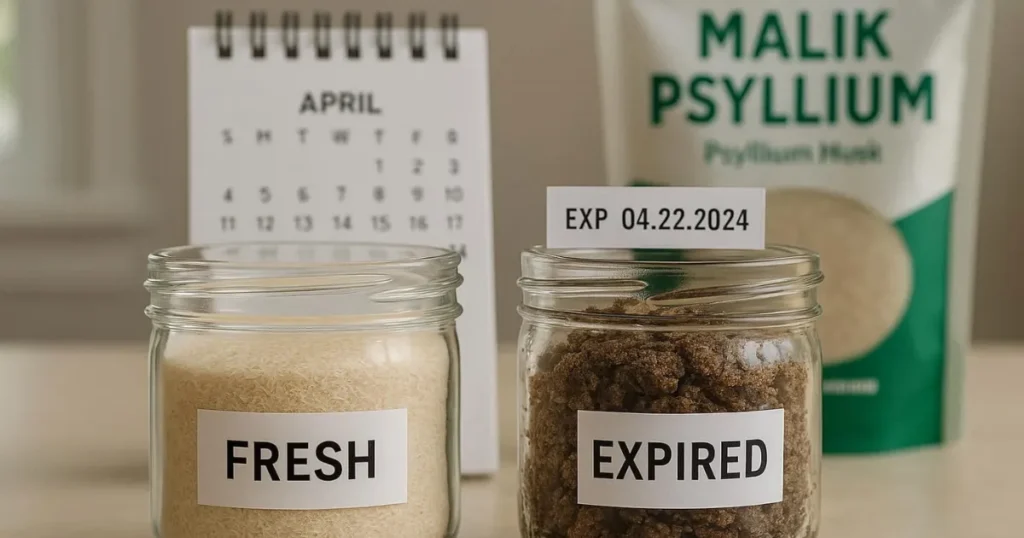
I’ll never forget the day a customer called me, concerned about a container of isabgol she’d found in her pantry. “Does isabgol expire?” she asked. “It’s been sitting here for three years, but it looks fine.” As someone who’s been growing and processing psyllium husk in Pakistan for decades, I hear this question often – and it deserves a thorough answer.
Yes, isabgol does expire. Understanding its shelf life isn’t just about avoiding waste; it’s about ensuring you’re getting the full digestive and health benefits this natural fiber offers. In this guide, I’ll share everything you need to know about isabgol expiration, storage, and safety based on years of hands-on experience.
Does Isabgol Expire? The Direct Answer
Let’s address this head-on: yes, isabgol absolutely does expire. The typical shelf life of packaged isabgol ranges from 2 to 3 years from the manufacturing date when unopened and stored properly.
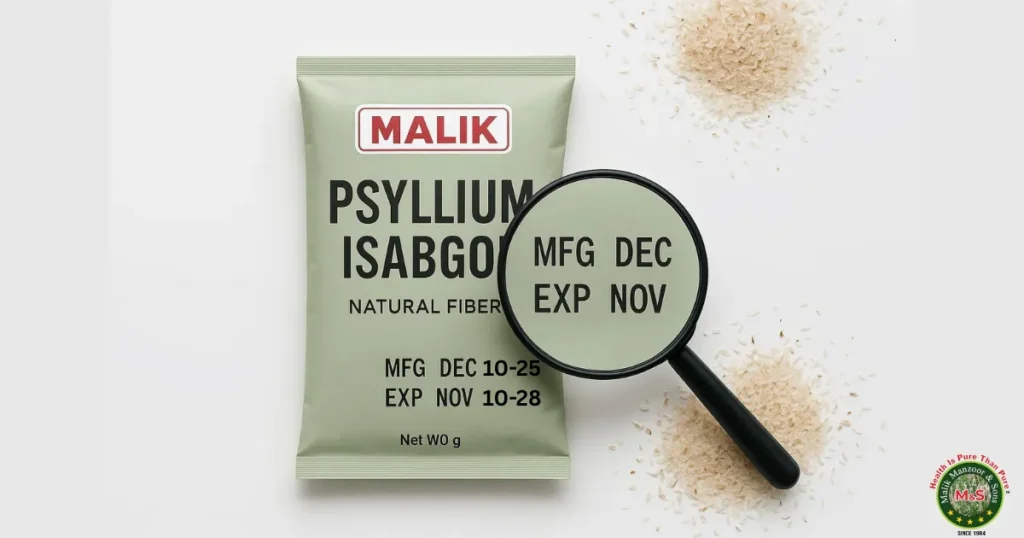
Understanding Natural Product Shelf Life
Isabgol is pure fiber from the Plantago ovata plant – specifically, the outer husk of the seed. Unlike synthetic supplements loaded with preservatives, isabgol is 100% natural. This is wonderful for your health, but it means it’s susceptible to degradation: oxidation, moisture absorption, and potential microbial growth.
Quick Fact Box:
Isabgol is a 100% natural fiber from Plantago ovata grown in Pakistan and India. Its purity means it’s sensitive to air, light, and humidity – which is why it has a limited shelf life. The lack of artificial preservatives is actually a mark of quality, not a deficiency.
What Happens When Does Isabgol Expire
Expired isabgol doesn’t suddenly become toxic overnight. Instead, it undergoes gradual changes:
Fiber potency decreases:
The soluble fiber breaks down, reducing its ability to absorb water and create that beneficial gel-like consistency
Physical changes occur:
The color may darken, the texture can become clumpy or sticky
Swelling capacity diminishes:
Fresh isabgol expands 8-10 times its volume; expired isabgol might barely swell
Contamination risk increases:
In humid environments, isabgol becomes vulnerable to mold and bacteria
At Malik Psyllium, we print clear expiration dates on every package because using expired isabgol means you’re not getting the digestive, cholesterol-lowering, or blood sugar benefits you’re seeking.
Understanding Isabgol’s Shelf Life in Different Forms
Not all isabgol is equal when it comes to shelf life. The form you purchase significantly affects how long it remains effective.
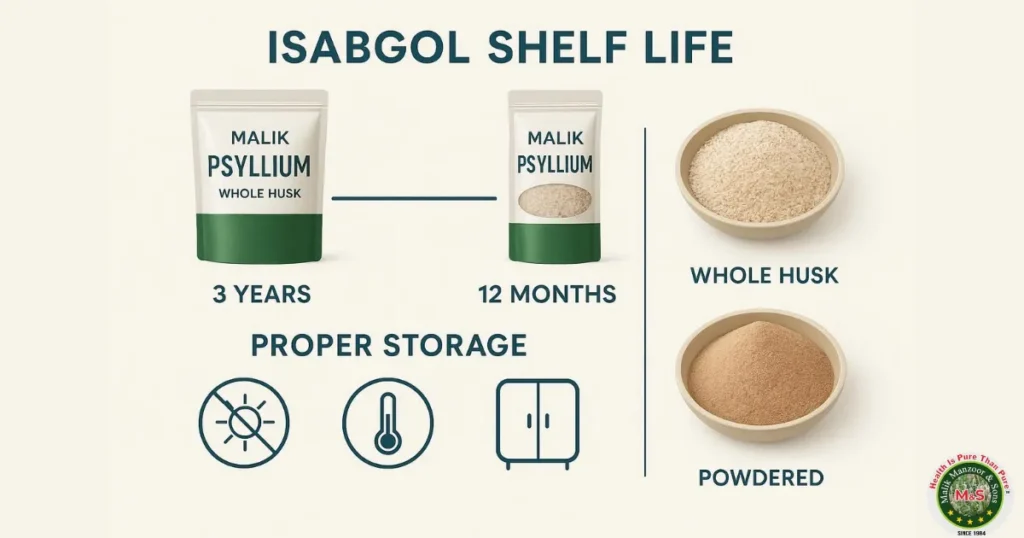
Whole Husk vs. Powdered Form
Whole husk isabgol consists of larger, flaky pieces with less surface area exposed to air. This form typically lasts longer – up to 3 years unopened and about 12 months after opening if stored correctly.
Powdered isabgol has been ground into finer particles, dramatically increasing surface area exposure. This makes it convenient to mix but more vulnerable to degradation. Expect a shelf life of about 2 years unopened and only 6-8 months after opening.
Unopened vs. Opened Containers
An unopened package of isabgol, sealed at our facility in Pakistan under controlled conditions, maintains its quality remarkably well. The moment you break that seal, however, you introduce moisture and oxygen.
Unopened isabgol benefits from factory-sealed packaging that blocks moisture, minimal oxygen exposure, and protection from light and temperature fluctuations.
Opened isabgol faces constant challenges, humid air enters each time you open it, temperature fluctuations occur, and there’s a risk of contamination from utensils.
I always recommend transferring opened isabgol to an airtight glass or steel container immediately.
Shelf Life Comparison Table
| Isabgol Type | Shelf Life (Unopened) | Shelf Life (After Opening) | Storage Sensitivity |
| Whole Husk | 3 years | 12 months | Moderate |
| Powdered Husk | 2 years | 6-8 months | High |
| Capsules | 2 years | 12 months | Low to Moderate |
How to Tell If Your Isabgol Has Expired
Knowing Does Isabgol expire? It isn’t always as simple as checking the date. Here are the definitive signs I’ve learned to recognize.

The Smell Test
Fresh isabgol has a very mild, almost neutral smell – slightly earthy but not unpleasant. When you open a container, you might detect a faint grain-like aroma, but nothing strong.
Red flags:
- Musty or moldy odor (indicates moisture exposure and potential fungal growth).
- Sour or fermented smell (suggests bacterial contamination).
- Any strong, unpleasant smell.
If your isabgol smells anything other than neutral, trust your nose.
Visual Inspection.
Pour some isabgol into a clean, dry bowl and examine it under good light.
Fresh isabgol characteristics:
- Pale cream to light tan color.
- Dry, fluffy texture with individual flakes.
- No clumping or sticky residue.
- Uniform appearance throughout.
Signs of expiration:
- Darkening to yellowish-brown or grayish tones.
- Clumping or formation of hard lumps.
- Visible moisture or sticky texture.
- Dark spots (potential mold).
The Swelling Test (Most Reliable).
This is the gold standard for determining if isabgol is still effective. If it doesn’t swell, it won’t work in your digestive system either.

How to perform the test:
- Take one level teaspoon of isabgol.
- Add to a clear glass with 200ml of room-temperature water.
- Stir briefly and observe.
- Set a timer for 3 minutes.
What you should see:
- Immediate beginning of swelling (within 30-60 seconds).
- Noticeable expansion within 2-3 minutes.
- Formation of gel-like consistency.
- Expansion to roughly 8-10 times the original volume.
Signs of expired isabgol:
- Minimal or no swelling after 5 minutes.
- Particles sink without expanding.
- Water becomes murky or discolored.
- Expansion to only 2-3 times the original size.
I’ve demonstrated this test hundreds of times, and it never fails to reveal isabgol quality.
Can You Safely Use Expired Isabgol?
Here’s where I need to be very clear: Does isabgol expire, and can you use it after? My answer is – yes, it expires, and I strongly advise against using it afterward.
What You Risk by Using Expired Isabgol.
Reduced effectiveness:
The most common issue. You might take expired isabgol faithfully every day, wondering why your constipation isn’t improving. The fiber has lost its potency.
Digestive discomfort:
Degraded isabgol can cause more problems than it solves. I’ve heard from people who experienced increased bloating, gas, and cramping after using old isabgol.
Microbial contamination:
If isabgol has been exposed to moisture, it becomes a potential breeding ground for mold and bacteria. You might not see visible mold, but microscopic contamination can occur.
In humid climates like parts of Pakistan, India, or Southeast Asia, this risk increases significantly.
My Professional Recommendation.
My advice is simple: don’t use expired isabgol. However, I understand that sometimes people find recently expired isabgol. Here’s my nuanced guidance:
Within 1-2 months past expiration:
- Perform all quality tests.
- If it passes smell, visual, and swelling tests perfectly.
- And it’s been stored properly in a dry, cool place.
- You might cautiously use it, but reduce expectations.
More than 2 months past expiration:
- Don’t risk it, regardless of appearance.
- Replace it with fresh isabgol.
Any time if stored poorly:
- If exposed to moisture, heat, or humidity.
- Discard immediately, regardless of date.
What Actually Happens If You Consume Expired Isabgol.
Mild cases (most common):
- Simply no benefit, no harm.
- Perhaps mild bloating or gas.
- Continued digestive issues.
Moderate cases (less common):
- Noticeable stomach discomfort or cramping.
- Increased bloating and gas.
- Possible mild diarrhea.
- General digestive upset lasting 24-48 hours.
Severe cases (rare):
- Significant gastrointestinal distress.
- Nausea and vomiting.
- Potential allergic-type reactions.
I want to emphasize that severe reactions are uncommon and usually only occur with very old isabgol that’s been badly stored.
How to Store Isabgol for Maximum Freshness.
Proper storage is the single most important factor in extending your isabgol’s shelf life. Following these guidelines can easily double the usable life of your isabgol.
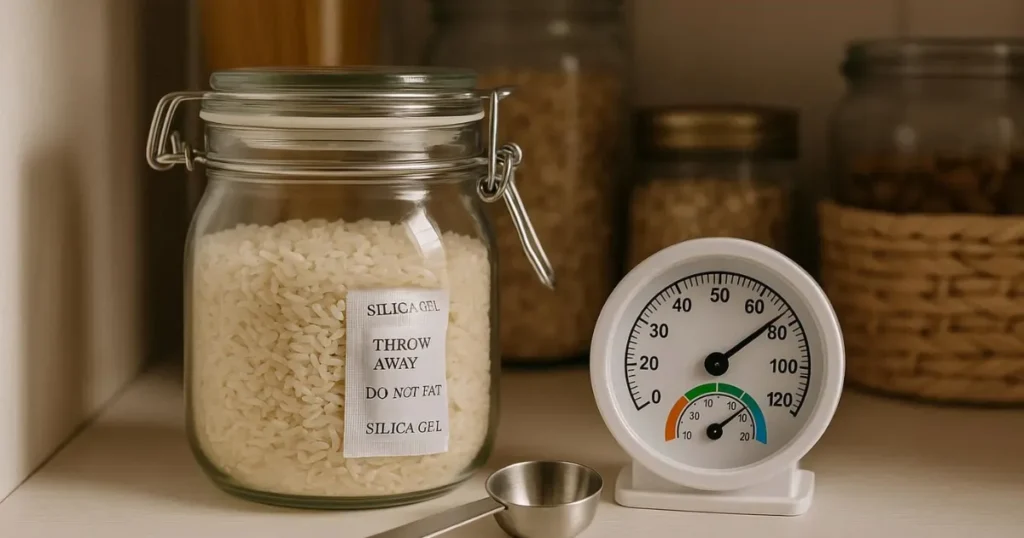
The Ideal Storage Conditions.
Temperature:
Cool and consistent, ideally between 15-25°C (59-77°F). Avoid areas with temperature fluctuations.
Humidity:
As low as possible. Isabgol’s worst enemy is moisture. Aim for environments with less than 60% relative humidity.
Light exposure:
Minimal to none. While isabgol isn’t as light-sensitive as some supplements, prolonged sunlight exposure can degrade its quality.
Air exposure:
Limited. Once opened, isabgol should be exposed to air only briefly when you’re scooping out your dose.
Container Selection Matters.
Best options:
1. Airtight glass jars:
My top recommendation. Glass doesn’t absorb moisture, doesn’t retain odors, and you can see the contents. Mason jars with rubber seals work excellently.
2. Stainless steel containers:
Also excellent. They block light completely and maintain airtight seals.
3. High-quality plastic containers:
If using plastic, choose food-grade, BPA-free options with truly airtight seals.
Avoid:
- Metal tins without proper sealing.
- Containers with poor-fitting lids.
- Clear plastic exposed to light.
- Anything previously used for strong-smelling foods.
Location, Location, Location.
Ideal locations:
- Kitchen pantry or cupboard (away from stove and sink, in a cool, dark corner).
- Bedroom closet (often cooler and less humid than kitchen areas).
- Dedicated dry storage room.
Acceptable locations:
- Refrigerator (good option in very humid climates – just ensure an airtight container).
Avoid these locations:
- Above or near the stove (heat and steam).
- Bathroom cabinet (high humidity).
- Near windows (temperature fluctuations and sunlight).
- Under the sink (potential leaks and humidity).
Daily Use Best Practices.
Always use a clean, dry spoon:
Never let a wet spoon touch your isabgol. I keep a dedicated wooden or steel spoon for isabgol only.
Close immediately:
Take your dose, close the container tightly, then prepare your drink.
Keep the rim clean:
Wipe any spilled isabgol from the container rim before sealing.
Climate-Specific Storage Advice.
Hot and humid climates (coastal areas, tropical regions):
- Refrigeration is your best option.
- Use double-sealing.
- Consider smaller package sizes.
- Check weekly for moisture signs.
Hot and dry climates (desert regions):
- Standard pantry storage works well.
- Still use airtight containers.
Temperate climates:
- Standard storage works perfectly.
- Just maintain consistent conditions.
Storage Checklist.
- Airtight container (glass or stainless steel preferred)
- Cool, dry location (15-25 °C)
- Away from direct sunlight
- Low humidity environment
- Clean, dry utensils only
- Tight seal after every use
- Labeled with the opening date
- Regular visual checks.
Expert Tips to Maximize Isabgol’s Shelf Life.
After decades in the psyllium industry, I’ve picked up numerous strategies that go beyond basic storage.
Buy Smart: Quality from the Start.
The shelf life of your isabgol begins before you purchase it.
Check the manufacturing date:
A product manufactured 6 months ago is better than one manufactured 2 years ago, even with the same expiration date.
Examine the packaging:
Quality brands invest in proper packaging – look for multi-layer moisture barriers and heat-sealed edges.
Choose the right quantity:
Don’t buy 1kg if you only use a teaspoon daily. Calculate how much you’ll use in 3-6 months and buy accordingly.
The Two-Container Method.
One of the smartest strategies is avoiding repeatedly opening your main supply:
- Keep bulk isabgol in a large, rarely-opened container.
- Transfer only 1-2 weeks’ worth to a smaller daily-use container.
- Refill the small container as needed.
- This minimizes how often your main supply is exposed to air.
Many Malik Psyllium customers who buy in bulk use this exact method successfully.
Add Silica Gel Packets.
Here’s an insider tip: adding food-grade silica gel packets to your isabgol container can significantly extend freshness. These desiccant packets absorb moisture that might enter when you open the container.
Drop 1-2 packets into your isabgol container – they won’t affect the fiber but will provide constant moisture protection.
The Quarterly Check System.
Don’t wait until you’re about to use isabgol to discover it’s gone bad. Implement a regular inspection routine.
Every 3 months:
- Visual inspection for color changes.
- Smell check.
- Quick swelling test with a small sample.
- Verify storage conditions haven’t changed.
Understanding Seasonal Variations.
Isabgol experiences different challenges depending on the season:
Summer/Monsoon season (high humidity):
- Check more frequently for moisture.
- Consider refrigeration.
- Be extra careful about using dry utensils.
Winter (in cold climates):
- Watch for condensation.
- Allow containers to reach room temperature before opening.
Dry seasons:
- Standard storage usually works perfectly.
- Best time to buy and store bulk quantities.
Does isabgol expire?
Yes, isabgol does expire. The typical shelf life is 2-3 years from the manufacturing date when unopened and properly stored. Once opened, isabgol should be used within 6-12 months, depending on the form. The expiration happens because isabgol is a natural, preservative-free fiber that gradually loses its potency and swelling capacity. Always check the printed expiration date and store properly to maximize usable life.
How long does isabgol last after opening?
After opening, isabgol typically lasts 6-12 months if stored properly in an airtight container in a cool, dry place. Whole husk form lasts closer to 12 months, while powdered isabgol should be used within 6-8 months. The key is protecting it from moisture, air, and temperature fluctuations. Mark your container with the opening date to track freshness, and consider refrigeration in humid climates.
What happens if I use expired isabgol?
Using expired isabgol is not recommended. While unlikely to be toxic, expired isabgol loses its fiber potency and swelling capacity, meaning you won’t get digestive benefits. You might experience reduced effectiveness for constipation relief, minimal impact on cholesterol or blood sugar, and potentially increased bloating or discomfort. If exposed to moisture, there’s also a risk of mold or bacterial contamination that could cause stomach upset.
How can I tell if isabgol has gone bad?
Check if isabgol has gone bad by performing several tests. First, smell it – fresh isabgol should have a neutral or mildly earthy scent, while expired isabgol may smell musty or sour. Second, inspect color and texture – it should be pale and fluffy, not darkened or clumpy. Third, perform a swelling test by mixing a teaspoon with water; it should expand to 8-10 times its size within 2-3 minutes. If it doesn’t swell properly, feels sticky, has dark spots, or shows mold, discard immediately.
Can I use isabgol past its expiration date?
I strongly advise against using isabgol past its expiration date. While it may not be immediately dangerous, the fiber loses effectiveness, and you risk consuming contaminated product, especially if stored in humid conditions. If isabgol is only 1-2 weeks past expiration, was stored perfectly, and passes all quality tests, you may use it with reduced expectations. Anything more than a month past expiration should be discarded regardless of appearance.
What is the best way to store isabgol?
The best way to store isabgol is in an airtight glass or stainless steel container in a cool, dry place away from direct sunlight. Keep it in a kitchen pantry or cupboard away from the stove and sink, where temperatures stay between 15-25 ° C and humidity is low. Always use a clean, dry spoon when scooping, and seal the container immediately after use. In humid climates, storing isabgol in the refrigerator helps maintain freshness. Adding food-grade silica gel packets provides extra moisture protection.
Does isabgol need to be refrigerated?
Isabgol doesn’t necessarily need refrigeration in most climates, but it can be beneficial in hot and humid regions. Refrigeration provides consistent cool temperatures and low humidity, which help preserve isabgol’s quality and extend shelf life. If you refrigerate isabgol, ensure it’s in a completely airtight container to prevent moisture from condensation. For people in moderate climates with proper storage conditions, a cool, dry pantry works perfectly fine without refrigeration.
Which isabgol brand has the longest shelf life?
Brand quality significantly impacts shelf life. Reputable brands like Malik Psyllium, Sat-Isabgol, and other established manufacturers invest in proper processing, quality packaging with moisture barriers, and careful handling – all extending shelf life to the full 2-3 years. The longest shelf life comes from brands using multi-layer packaging, oxygen absorbers, and proper sealing techniques. However, the stated shelf life is less important than the actual manufacturing date. A premium brand’s recently manufactured product is always better than any brand’s product sitting on shelves for years.
Conclusion – Fresh Isabgol for Maximum Benefits.
After covering everything about whether isabgol expires, one thing should be crystal clear: yes, does isabgol expire – and using fresh product matters significantly for your health outcomes. This isn’t just about avoiding spoilage; it’s about ensuring you actually get the digestive support, cholesterol management, and fiber benefits that isabgol is known for.
The good news is that with proper storage – an airtight container, cool and dry conditions, and careful handling – your isabgol will maintain quality throughout its entire 2-3 year shelf life. Simple habits like using dry utensils, sealing containers immediately, and checking for deterioration signs make all the difference.
Remember: when in doubt, throw it out. The cost of replacing isabgol is minimal compared to the value of your health. If your isabgol shows any signs of expiration – strange odor, discoloration, clumping, or failed swelling test – replace it without hesitation.
At Malik Psyllium, we cultivate and process isabgol in Pakistan with meticulous attention to quality, ensuring every package is fresh, pure, and properly sealed for maximum shelf life. But even the highest quality isabgol requires proper care once it reaches your home. Follow the storage guidelines I’ve shared, perform regular quality checks, and don’t hesitate to replace old product with fresh isabgol.
Your digestive health deserves the best. Choose quality isabgol, store it properly, and replace it before it expires. Your body will thank you. Have you got the answer: Does isabgol expire? Let us know if you have more questions.
Malik Shabbir
Featured Blogs

Psyllium Husk in Urdu Meaning: Complete Guide to اسپغول Benefits & Uses
After three decades of cultivating and supplying psyllium worldwide, I’m
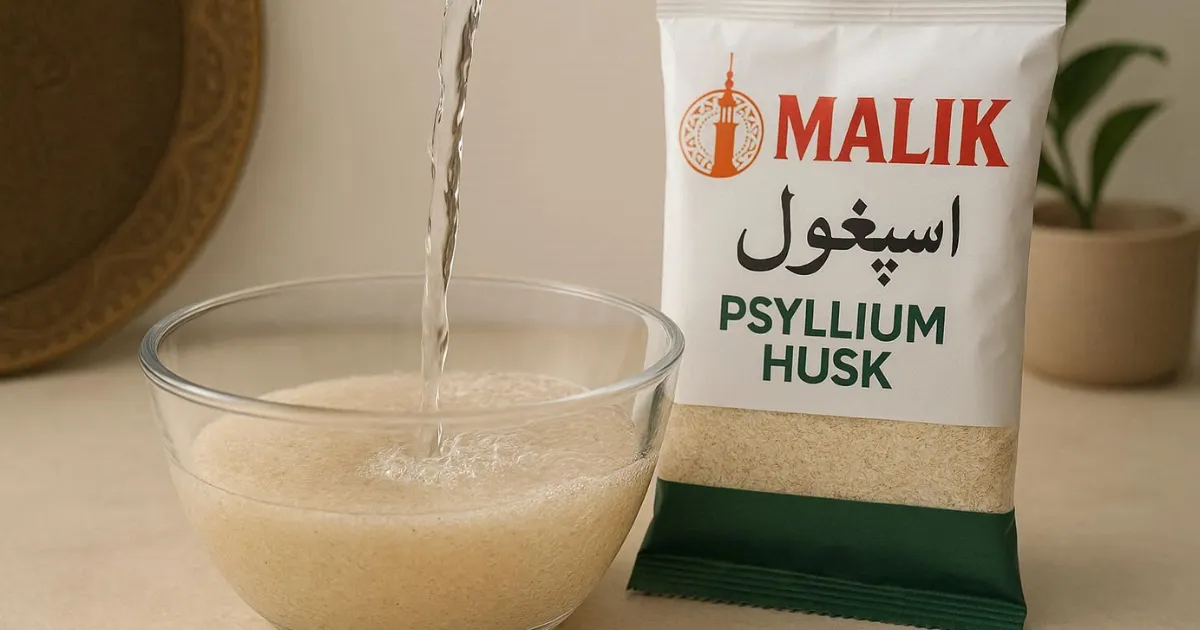
Psyllium Husk in Urdu: Complete Guide to اسپغول چھلکا Benefits & Uses – 2025
After three decades of cultivating and supplying psyllium across six
